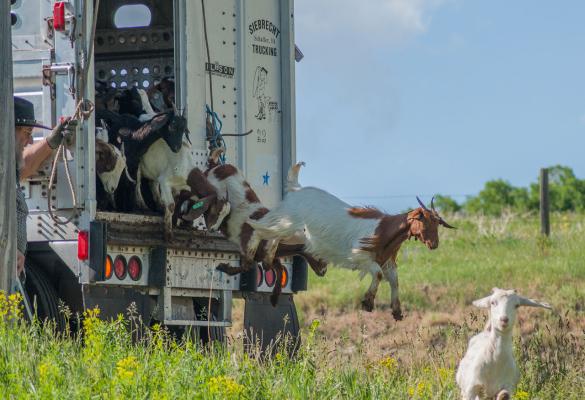Invasive and Nuisance Plant Species Removal
An invasive or nuisance pest is a species that causes harm to humans or the environment (USGS n.d.). Unlike invasive species, nonnative species are organisms that do not occur naturally in an area but do not necessarily cause harm. Nonnative species are typically introduced to areas by humans (NPS 2020). Nuisance species can either be native or nonnative, but they always cause ecological or economic harm (Gwise 2021). This summary focuses on invasive plant species. In 2012, there were an estimated 5,000 nonnative plant species within the United States. While not all are invasive, there is still potential for these plants to spread and cause harm (Kerns and Guo, 2012). Management of invasive and nuisance plant species can benefit both the ecosystem and the economy (Gwise 2021).

Case Studies
Anthro Mountain Greater Sage Grouse Habitat Restoration
Anticipating and Preventing the Spread of Invasive Plants
Beat Back Buffelgrass: Trans-Jurisdictional, Volunteer-Driven Invasive Species Treatment
Blue Hole Cienega Restoration Project
Buffelgrass Removal, Fire, and Climate Adaptation at Saguaro National Park
Chatfield Reservoir-Plum Creek
Clinton River Mouth Wetland Restoration
Collaborative Restoration Partnerships in the Colorado River Basin
Creating Refuge for Mohave Tui Chub at Mojave National Preserve
Cumberland Sandstone Glade Restoration at the William B. Bankhead National Forest
Desert Tortoise Habitat Restoration Methods for the Eastern Mojave
Dolores River Restoration Partnership: A Public-Private Collaborative for Riparian Restoration
EDRR Management of Japanese knotweed following extreme flooding
Early Tallgrass Prairie Restoration at Homestead National Historical Park
Five Creeks Rangelands Restoration
Fowl Meadow Purple Loosestrife Biological Control Project
Giant Salvinia Control in Lake Raven
Gila Watershed Partnership: Restoration to Mitigate Tamarisk Beetle Impacts
Goats as a Tool for Fire Management on the Pueblo of Sandia
Habitat Restoration Within the Middle Rio Grande of New Mexico
Habitat Restoration and Bullfrog Removal in Support of Northern Leopard Frog Conservation
Healthy Forest, Healthy Wildlife: The Wilds, Cumberland, Ohio
Helping Pollinators Adapt to Climate Change
Herbicide Treatment of Western Honey Mesquite in Texas Grasslands
Herring River Tidal Restoration Project
Horner Park Restoration Project
Improving Pollinator Habitat on McConnell Air Force Base
Jackson Park Ecosystem Restoration
Kelly Hayfields Sagebrush Habitat Restoration
Kenilworth Marsh Tidal Wetland Restoration, Washington D.C.
Knox County, Indiana Bans the Distribution of 64 Invasive Plants
Maidford River Saltmarsh Restoration: Middletown, Rhode Island
Mimbres River Habitat Restoration for the Chihuahua Chub and Chiricahua Leopard Frog
Multi-Species Grassland Restoration in the Bonita Area of Southeastern Arizona
Oak Savanna Restoration along an Urban River
Ohkay Owingeh (San Juan Pueblo) Riparian Restoration
Pecos National Historical Park Glorieta Creek Wetland-Riparian Restoration
Rangeland Restoration Following the Martin Fire in Reno, Nevada
Reintroducing Beavers to Facilitate Riparian Restoration on the Zuni Reservation
Removing Invasive Plants from the Great Meadow
Research and Collaboration to Improve Amargosa Vole Conservation in the Lower Amargosa River
Restoration of Diamondback Terrapin Nesting Habitat along the Potowomut River
Restoration of Ecosystem Health in Southwest Forests Project
Restoration of Riparian Trees and Shrubs on the Rio Grande Canalization Project
Riparian Restoration Experiment for Native Species Conservation in Vermont
Shrub Control to Restore a Coastal Prairie Ecosystem
Southwest Florida Assesses Salt Marsh Vulnerability to Sea Level Rise
Spring Peeper Meadow Restoration Project
Steigerwald Reconnection Project
The Duralde Cajun Prairie Restoration Project, Evangeline Parish
Treatment of Non-Native Lovegrasses at Appleton-Whittell Research Ranch
USA: Richmond Heritage Trail “Hike Through History," Rhode Island
Using a Mobile App and Remote Sensing to Map, Monitor and Control Invasive Plants
Wastewater Recharge and Wetland Construction by the City of Tucson
Tools
A Management Guide for Invasive Plants in Southern Forests
Bureau of Land Management (BLM) National Invasive Species Information Management System (NI-SIMS)
Field Guide for Managing Cheatgrass in the Southwest
Field Guide: Invasive Plant Inventory, Monitoring, and Mapping Protocol
Impact Evaluation on EarthCorps Restoration Methods
Invasive Aquatic Plant Control and Management Guide
Invasive Species Management Plan for the Saginaw Chippewa Indian Tribe
Land Manager's Guide to Developing an Invasive Plant and Management Plan
Midwest Invasive Plant Network: Invasive Plant Control Database
Likely Benefits and Outcomes
This strategy is likely to achieve these project goals. Click to search for strategies with a similar benefit.
Related Green (natured-based) vs. Gray infrastructure
Explore opportunities to replace or supplement gray infrastructure with green infrastructure options.
